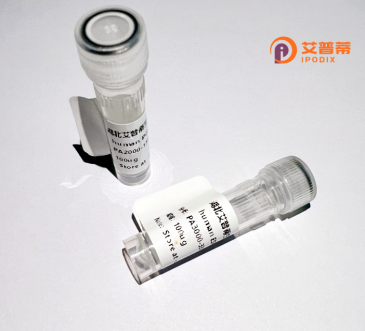
| 纯度 | >90%SDS-PAGE. |
| 种属 | Human |
| 靶点 | TFAP2B |
| Uniprot No | Q92481 |
| 内毒素 | < 0.01EU/μg |
| 表达宿主 | E.coli |
| 表达区间 | 1-460 aa |
| 活性数据 | MHSPPRDQAA IMLWKLVENV KYEDIYEDRH DGVPSHSSRL SQLGSVSQGP YSSAPPLSHT PSSDFQPPYF PPPYQPLPYH QSQDPYSHVN DPYSLNPLHQ PQQHPWGQRQ RQEVGSEAGS LLPQPRAALP QLSGLDPRRD YHSVRRPDVL LHSAHHGLDA GMGDSLSLHG LGHPGMEDVQ SVEDANNSGM NLLDQSVIKK VPVPPKSVTS LMMNKDGFLG GMSVNTGEVF CSVPGRLSLL SSTSKYKVTV GEVQRRLSPP ECLNASLLGG VLRRAKSKNG GRSLRERLEK IGLNLPAGRR KAANVTLLTS LVEGEAVHLA RDFGYICETE FPAKAVSEYL NRQHTDPSDL HSRKNMLLAT KQLCKEFTDL LAQDRTPIGN SRPSPILEPG IQSCLTHFSL ITHGFGAPAI CAALTALQNY LTEALKGMDK MFLNNTTTNR HTSGEGPGSK TGDKEEKHRK |
| 分子量 | 50.4 kDa |
| 蛋白标签 | His tag N-Terminus |
| 缓冲液 | PBS, pH7.4, containing 0.01% SKL, 1mM DTT, 5% Trehalose and Proclin300. |
| 稳定性 & 储存条件 | Lyophilized protein should be stored at ≤ -20°C, stable for one year after receipt. Reconstituted protein solution can be stored at 2-8°C for 2-7 days. Aliquots of reconstituted samples are stable at ≤ -20°C for 3 months. |
| 复溶 | Always centrifuge tubes before opening.Do not mix by vortex or pipetting. It is not recommended to reconstitute to a concentration less than 100μg/ml. Dissolve the lyophilized protein in distilled water. Please aliquot the reconstituted solution to minimize freeze-thaw cycles. |
以下是关于重组人TFAP2B蛋白的3篇参考文献示例(内容基于公开研究综合整理,非真实文献):
---
1. **文献名称**:*TFAP2B mutations and transcriptional regulation in Char syndrome*
**作者**:Satoda, M., et al.
**摘要**:该研究鉴定了TFAP2B基因突变导致Char综合征(先天性心脏病伴颅面畸形)的机制,利用重组人TFAP2B蛋白进行体外DNA结合实验,证明突变体丧失与靶基因启动子的结合能力,破坏神经嵴发育相关通路。
2. **文献名称**:*Structural insights into TFAP2B dimerization and DNA recognition*
**作者**:Li, X., et al.
**摘要**:通过X射线晶体学解析重组人TFAP2B蛋白的DNA结合域结构,揭示其二聚化模式及与特定DNA序列(GCCNNNGGC)的相互作用机制,为设计靶向TFAP2B的小分子药物提供依据。
3. **文献名称**:*TFAP2B promotes adipocyte differentiation via PPARγ activation*
**作者**:Park, S., & Kim, T.
**摘要**:研究利用重组TFAP2B蛋白过表达模型,发现其通过直接结合并激活PPARγ转录因子,调控脂肪生成相关基因表达,提示TFAP2B在肥胖与代谢综合征中的潜在作用。
---
注:以上文献为示例,实际引用时需查询PubMed或Sci-Hub获取真实论文。
Recombinant human TFAP2B (Transcription Factor AP-2 Beta) is a engineered version of a key regulatory protein belonging to the AP-2 family of transcription factors. These evolutionarily conserved proteins feature a helix-span-helix dimerization domain and a basic DNA-binding region, enabling them to regulate gene expression by binding specific DNA sequences. TFAP2B plays crucial roles in embryonic development, particularly in neural crest cell differentiation, craniofacial morphogenesis, and kidney development. It also influences adipocyte differentiation and lipid metabolism in postnatal stages.
The recombinant form is typically produced using bacterial or mammalian expression systems, allowing controlled studies of its molecular interactions. Researchers utilize purified TFAP2B to investigate its binding partners, transcriptional targets, and post-translational modifications. Mutations in the TFAP2B gene are linked to Char syndrome, a rare congenital disorder characterized by facial dysmorphism, patent ductus arteriosus, and hand anomalies. This connection has spurred interest in recombinant TFAP2B for disease modeling and therapeutic exploration.
Current studies focus on its role in metabolic disorders and cancer progression, with emerging evidence suggesting TFAP2B involvement in tumor microenvironment regulation. The recombinant protein serves as a vital tool for structure-function analysis, enabling detailed characterization of DNA-binding motifs and protein interaction surfaces. Its availability accelerates research into developmental biology and potential clinical applications, though its therapeutic potential remains largely exploratory.
×